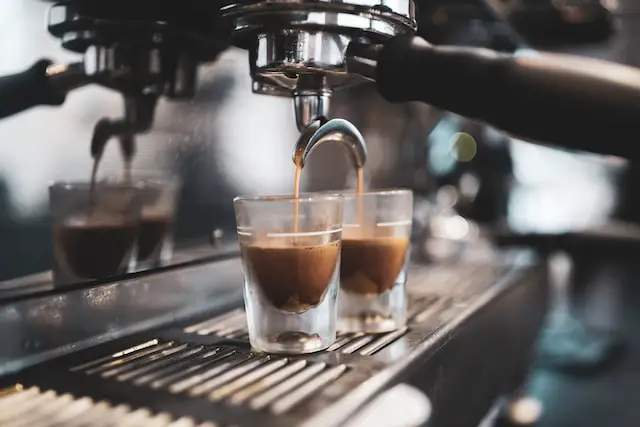What is the most expensive espresso machines? Are expensive espresso machines better? Why is the La Marzocco espresso machine so expensive? What is the best espresso machine? What espresso machine does Brad Pitt use? Why are Italian espresso machines so expensive? Why is Breville so expensive? How much should you pay for an espresso machine? Why does espresso taste better in Italy? What is the Italian rule for espresso? Maybe you have had these questions. After reading this article, you will know the answers. I hope this article can help you.
10 Most Expensive Espresso Machines
Dalla Corte Studio Blaze – $4,650
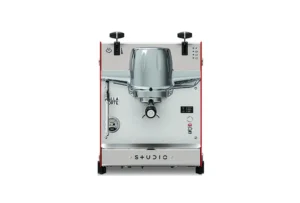
Dalla Corte Studio Blaze is the 10th most expensive espresso machine in the world. Dalla Corte is a modern Italian brand that has been making espresso machines since 2001. The Studio Blaze is a compact and stylish machine that can fit in any space. It has a matte black body, with a red accent and a digital display.
The Studio Blaze has a single group head, but it can brew two espressos at the same time, thanks to its multi-boiler system. It also has a steam wand that can froth milk for cappuccinos, lattes, and other drinks. The Studio Blaze is a smart and innovative machine that can connect to a smartphone app, allowing the user to customize the settings and monitor the performance.
The Studio Blaze is a perfect machine for those who want to enjoy espresso at home, without compromising on quality or convenience.
Elektra Sixties T1 Deliziosa – $5,200
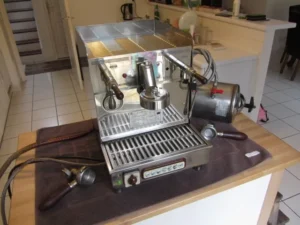
Elektra Sixties T1 Deliziosa is the 9th most expensive espresso machine in the world. Elektra is another renowned Italian brand that has been making espresso machines since 1947.
The Sixties T1 Deliziosa is a retro-style machine that pays homage to the golden age of espresso. It has a shiny chrome body, with a dome-shaped top and a circular pressure gauge.
The Sixties T1 Deliziosa has a single group head, but it can brew two espressos at the same time, thanks to its heat exchanger system. It also has a steam wand that can froth milk for cappuccinos, lattes, and other drinks. The Sixties T1 Deliziosa is a simple and elegant machine that can add a touch of nostalgia and charm to any kitchen.
Victoria Arduino E1 Prima Matt Black – $6,000
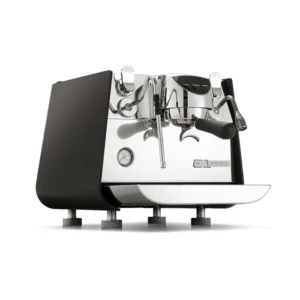
Victoria Arduino E1 Prima Matt Black is the 8th most expensive espresso machine in the world. Victoria Arduino is a prestigious Italian brand that has been making espresso machines since 1905. The E1 Prima is one of their latest models, designed for both home and professional use. It features a sleek and elegant design, with a matte black finish and a touchscreen interface.
The E1 Prima has a single group head, but it can brew two espressos at the same time, thanks to its dual boiler system. It also has a steam wand that can froth milk for cappuccinos, lattes, and other drinks. The E1 Prima is equipped with a smart water system that can adjust the temperature and pressure according to the water quality, ensuring optimal extraction and flavor.
The E1 Prima is a versatile and reliable machine that can satisfy any coffee lover’s needs.
Rocket Espresso R Nine – $6,500
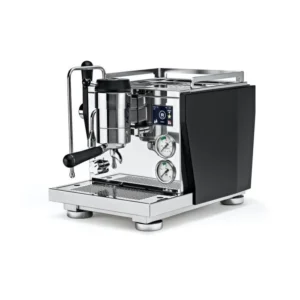
Rocket Espresso R Nine is the 7th most expensive espresso machine in the world. Rocket Espresso is a young Italian brand that has been making espresso machines since 2007.
The R Nine is a professional-grade machine that can deliver exceptional espresso. It has a stainless steel body, with a polished finish and a minimalist design. The R Nine has a single group head, but it can brew two espressos at the same time, thanks to its dual boiler system. It also has a steam wand that can froth milk for cappuccinos, lattes, and other drinks.
The R Nine is a powerful and precise machine that can control the temperature and pressure with accuracy, thanks to its PID controller and pressure profiling system. The R Nine is a machine for those who want to experience the art and science of espresso making.
Kaffeselskabet Crown – $6,600
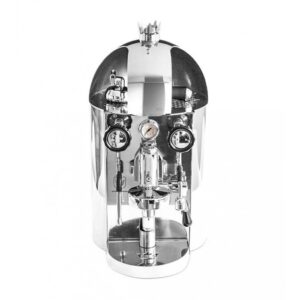
Kaffeselskabet Crown is the 6th most expensive espresso machine in the world. Kaffeselskabet is a Danish brand that has been making espresso machines since 2015.
The Crown is a unique and luxurious machine that can impress anyone. It has a brass body, with a gold-plated finish and a crown-shaped top. The Crown has a single group head, but it can brew two espressos at the same time, thanks to its dual boiler system. It also has a steam wand that can froth milk for cappuccinos, lattes, and other drinks.
The Crown is a stunning and extravagant machine that can make any coffee lover feel like royalty.
Faema E61 Jubilé A1 1 Group Automatic – $8,440
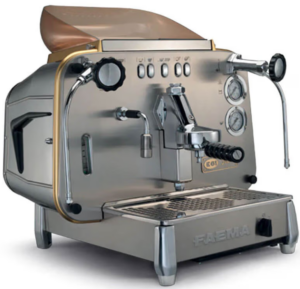
Faema E61 Jubilé A1 1 Group Automatic is the 5th most expensive espresso machine in the world. Faema is a legendary Italian brand that has been making espresso machines since 1945.
The E61 Jubilé is a classic and iconic machine that can make history. It has a stainless steel body, with a curved shape and a lever-operated group head. The E61 Jubilé has a single group head, but it can brew two espressos at the same time, thanks to its heat exchanger system. It also has a steam wand that can froth milk for cappuccinos, lattes, and other drinks.
The E61 Jubilé is a timeless and influential machine that can produce a perfect espresso, thanks to its revolutionary E61 group head, which was invented by Faema in 1961 and is still used by many machines today.
Aviatore Veloce TurboJet – $21,565

Aviatore Veloce TurboJet is the 4th most expensive espresso machine in the world. Super Veloce is a South African brand that has been making espresso machines since 2013.
The Aviator Veloce TurboJet is a spectacular and extravagant machine that can thrill any coffee lover. It has a metal body, with a shape and design that resembles a jet engine. The Aviator Veloce TurboJet has a single group head, but it can brew two espressos at the same time, thanks to its dual chamber system. It also has a steam wand that can froth milk for cappuccinos, lattes, and other drinks.
The Aviator Veloce TurboJet is a stunning and exclusive machine that can make espresso and tea, using carbon fiber, titanium, and aviation-grade aluminum. Only 100 of these machines have been produced, making them a rare and collectible item.
SanRemo OPERA Volumetric Espresso Machine – $29,216

SanRemo OPERA Volumetric Espresso Machine is the 3rd most expensive espresso machine in the world. SanRemo is a prominent Italian brand that has been making espresso machines since 1978.
The OPERA Volumetric is a high-end and elegant machine that can create a symphony of espresso. It has a black body, with a glossy finish and a touchscreen interface. The OPERA Volumetric has three group heads, each with a volumetric system that can measure the amount of water and coffee, ensuring consistent and accurate results. It also has three steam wands that can froth milk for cappuccinos, lattes, and other drinks.
The OPERA Volumetric is a refined and advanced machine that can optimize the extraction and flavor of each espresso, thanks to its temperature stability and pressure profiling system.
La Marzocco Strada Electronic Paddle – $33,000
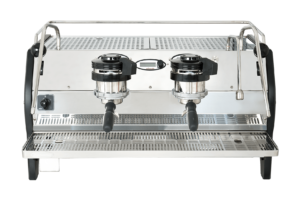
La Marzocco Strada Electronic Paddle is the 2nd most expensive espresso machine in the world. La Marzocco is a leading Italian brand that has been making espresso machines since 1927.
The Strada Electronic Paddle is a cutting-edge and sophisticated machine that can push the boundaries of espresso. It has a stainless steel body, with a sleek and modern design.
The Strada Electronic Paddle has three group heads, each with an electronic paddle that can control the pressure and flow of water, allowing the user to customize the extraction and flavor of each espresso. It also has three steam wands that can froth milk for cappuccinos, lattes, and other drinks. The Strada Electronic Paddle is a state-of-the-art and versatile machine that can cater to any coffee lover’s preferences.
Slayer 24-Karat Gold Espresso Machine – $75,000
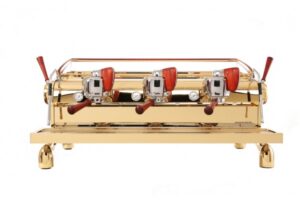
Slayer 24-Karat Gold Espresso Machine is the most expensive espresso machine in the world. Slayer is a prestigious American brand that has been making espresso machines since 2007.
The Slayer 24-Karat Gold is a magnificent and luxurious machine that can dazzle any coffee lover. It has a metal body, with a 24-karat gold-plated finish and a wooden handle. The Slayer 24-Karat Gold has three group heads, each with a manual paddle that can control the pressure and flow of water, allowing the user to craft the extraction and flavor of each espresso. It also has three steam wands that can froth milk for cappuccinos, lattes, and other drinks.
The Slayer 24-Karat Gold is a splendid and extravagant machine that can make espresso with style and flair, using the best materials and technology available. The Slayer 24-Karat Gold is the most expensive espresso machine in the world, with a price tag of $75,000.
Frequently Asked Questions
What is the most expensive espresso maker?
The crown for the most expensive espresso maker goes to the “Slayer 24-Karat Gold Espresso Machine.” This magnificent and luxurious coffee-making masterpiece comes with a jaw-dropping 24-karat gold-plated finish, making it not just an espresso machine but a true work of art. Crafted by the prestigious American brand Slayer, this espresso machine is a symbol of extravagance and style.
With three group heads, each featuring a manual paddle to control the pressure and flow of water, the Slayer 24-Karat Gold Espresso Machine offers a level of customization that elevates the espresso-making experience. Accompanied by three steam wands for frothing milk to perfection, this machine is designed for those who appreciate the finest materials and the pinnacle of technology in their coffee rituals.
As the most expensive espresso machine in the world, the Slayer 24-Karat Gold comes with a hefty price tag of $75,000, making it a true indulgence for those who want their coffee experience to be as opulent as it is flavorful.
Are expensive espresso machines better?
The performance and quality of espresso machines can vary widely across different price ranges. While expensive espresso machines often come with advanced features, high-quality materials, and precise engineering, whether they are “better” depends on individual preferences, needs, and expectations.
Here are some factors to consider:
- Build Quality: Expensive espresso machines often boast superior build quality, using premium materials that contribute to durability and longevity.
- Features: Higher-end machines may offer advanced features such as dual boilers, pressure profiling, temperature stability, and programmability. These features provide more control over the brewing process.
- Customization: Expensive machines often allow users to fine-tune various parameters, catering to individual taste preferences. This level of customization may not be as extensive in more affordable options.
- Design and Aesthetics: Luxury machines often come with stylish designs and premium finishes, adding an aesthetic appeal to your kitchen.
- Brand Reputation: Some expensive espresso machines are produced by well-established and reputable brands known for their expertise in coffee-making equipment.
However, it’s essential to note that being expensive doesn’t always guarantee a better coffee experience. Many mid-range and even budget-friendly espresso machines can produce excellent espresso, especially if they meet your specific needs and brewing preferences.
Ultimately, the “best” espresso machine for you depends on factors such as your budget, how involved you want to be in the brewing process, and the specific features that matter most to you. It’s a good idea to consider your own requirements and read reviews to find a machine that aligns with your expectations.
Why is the La Marzocco espresso machine so expensive?
La Marzocco espresso machines are renowned for their quality, craftsmanship, and advanced features, which contribute to their higher price. Several factors contribute to the elevated cost of La Marzocco espresso machines:
- High-Quality Materials: La Marzocco uses premium materials in the construction of their machines. Stainless steel, copper, and other durable components are often employed, ensuring longevity and resistance to wear and tear.
- Craftsmanship: The production of La Marzocco machines involves meticulous craftsmanship. Skilled artisans assemble and fine-tune each machine to meet exacting standards. The attention to detail contributes to the overall quality and performance of the espresso machine.
- Advanced Technology: La Marzocco is at the forefront of espresso machine innovation. Their machines often feature advanced technology such as dual boiler systems, PID temperature control, pre-infusion, and pressure profiling. These features provide precise control over the brewing process, resulting in high-quality espresso.
- Brand Reputation: La Marzocco has a long history (since 1927) and a stellar reputation in the coffee industry. The brand is associated with excellence and is trusted by many professional baristas and coffee enthusiasts. The reputation adds to the perceived value of their machines.
- Commercial-Grade Performance: Many La Marzocco machines are designed for commercial use, where durability and consistency are paramount. The engineering required to meet these demands often adds to the cost.
- Aesthetic Design: La Marzocco places emphasis on the design of their machines. The sleek and aesthetically pleasing appearance, combined with functional design elements, contributes to the overall appeal but may also increase production costs.
- Exclusivity: La Marzocco espresso machines are considered a symbol of quality and excellence. The exclusivity associated with owning a La Marzocco machine can contribute to its higher price.
In summary, the combination of premium materials, meticulous craftsmanship, advanced technology, brand reputation, commercial-grade performance, aesthetic design, and exclusivity all contribute to the higher price of La Marzocco espresso machines. While they may be an investment, many coffee professionals and enthusiasts consider them worth the cost for the exceptional coffee-making experience they deliver.
What is the best espresso machine?
Determining the “best” espresso machine depends on various factors, including your budget, preferences, and specific needs. Different users may prioritize different features, such as ease of use, customization options, build quality, or advanced technology. Here are a few espresso machines that are widely recognized for their quality and performance:
- Breville BES870XL Barista Express:
- A popular choice for home users.
- Integrated conical burr grinder for freshly ground coffee.
- Provides control over grind size, grind amount, and extraction time.
- Gaggia Classic Pro:
- Known for its simplicity and durability.
- Classic design with a commercial-style portafilter.
- Suitable for users who want a traditional espresso experience.
- Rancilio Silvia Espresso Machine:
- Sturdy and well-built machine with a classic design.
- Features a commercial-grade portafilter for consistent results.
- Known for producing high-quality espresso.
- La Marzocco Linea Mini:
- A professional-grade machine scaled down for home use.
- Dual boiler system for simultaneous brewing and steaming.
- Excellent build quality and design.
- Rocket Espresso Appartamento:
- Stylish design with high-quality construction.
- Compact size suitable for smaller spaces.
- Dual boiler system for enhanced performance.
- De’Longhi Magnifica ESAM3300:
- Automatic machine with a built-in grinder.
- Offers programmable settings for coffee strength and cup size.
- Ideal for users who prefer convenience.
- Nuova Simonelli Oscar II:
- Compact and versatile machine with professional features.
- Heat exchange boiler for simultaneous brewing and steaming.
- Suitable for both home and small commercial use.
- Sage Oracle Touch:
- Fully automatic machine with touchscreen controls.
- Integrated grinder and automatic milk frother.
- Offers a high level of automation for convenience.
- Expobar Office Lever Semi-Automatic Espresso Machine:
- Semi-automatic machine with a lever for manual control.
- Commercial-grade components for durability.
- Allows for hands-on espresso brewing.
- Lelit Bianca PL162T:
- Dual boiler system with PID temperature control.
- Manual profiling of pressure and flow rate for customization.
- Sleek design with wooden accents.
It’s essential to consider your specific requirements, whether you prefer a manual, semi-automatic, or automatic machine and your budget when choosing the best espresso machine for your needs. Additionally, reading user reviews and seeking recommendations can provide valuable insights.
Why are Italian espresso machines so expensive?
Italian espresso machines are often considered the epitome of craftsmanship and quality in the coffee industry, and several factors contribute to their relatively higher prices:
- High-Quality Materials: Italian espresso machines are typically constructed using premium materials such as stainless steel, brass, and copper. These materials contribute to the durability, longevity, and overall robustness of the machines.
- Craftsmanship: Italian manufacturers have a long history and tradition of artisanal craftsmanship. Skilled artisans and engineers meticulously assemble and fine-tune each machine, ensuring precision and attention to detail.
- Advanced Technology: Many Italian espresso machines incorporate advanced brewing technology, such as dual boiler systems, PID temperature control, and pressure profiling. These features enhance the precision and consistency of the brewing process, but they also contribute to the overall cost of the machine.
- Brand Reputation: Italian brands like La Marzocco, Elektra, and Rocket Espresso have established a strong reputation for producing high-quality espresso machines. The brand’s reputation for excellence can add to the perceived value of the machines.
- Commercial-Grade Performance: Some Italian espresso machines are designed for commercial use, where durability and consistency are critical. The engineering required to meet the demands of commercial settings can result in higher manufacturing costs.
- Aesthetic Design: Italian espresso machines often boast stylish and aesthetically pleasing designs. The combination of functionality and visual appeal requires additional design work and can contribute to the higher cost.
- Exclusivity: Italian espresso machines are often associated with a sense of exclusivity and luxury. The limited production of certain models or the use of unique materials may further contribute to their higher price.
- Import Costs: If you are purchasing an Italian espresso machine outside of Italy, import costs, taxes, and shipping fees can add to the overall price.
In summary, the combination of high-quality materials, artisanal craftsmanship, advanced technology, brand reputation, commercial-grade performance, aesthetic design, exclusivity, and import costs collectively contribute to the higher prices of Italian espresso machines. While they may be considered an investment, many coffee enthusiasts find the quality and performance of these machines to be worth the cost.
Why is Breville so expensive?
Breville offers a range of kitchen appliances, including espresso machines, and the pricing of their products can vary depending on the model and features. Breville is generally known for providing high-quality, innovative appliances, and several factors contribute to the perceived cost of their products:
- Innovative Technology: Breville is known for incorporating advanced and innovative technology into their appliances. Their espresso machines often come with features like integrated grinders, customizable settings, and automation, which can contribute to a higher price point.
- Build Quality: Breville products are typically constructed using durable materials and with attention to build quality. Sturdy construction and reliable performance can add to the overall cost of production.
- Design: Breville places emphasis on the design of their products. Sleek and modern designs, user-friendly interfaces, and attention to aesthetics contribute to the appeal of their appliances, potentially justifying a higher price.
- Brand Reputation: Breville has built a reputation for producing high-quality kitchen appliances with a focus on innovation and user convenience. The brand’s positive reputation may contribute to the perceived value of their products.
- Performance Features: Breville espresso machines often come with features that enhance the brewing experience, such as PID temperature control, pressure profiling, and programmable settings. These performance features can contribute to a higher price.
- Integrated Grinders: Some Breville espresso machines come with integrated conical burr grinders, allowing users to grind coffee beans fresh for each shot. The inclusion of such features can increase the overall cost of the machine.
- Customer Support and Warranty: Breville typically offers strong customer support and warranties for their products. The assurance of reliable customer service and warranties may contribute to the perceived value of the product.
It’s important to note that the cost of Breville products can vary across different models, and individual preferences and needs will play a role in determining whether the features and quality justify the price for each consumer. While some may find Breville products to be relatively expensive, others may view them as a worthwhile investment in quality and functionality.
How much should you pay for an espresso machine?
The price range for espresso machines is quite broad, and how much you should pay depends on your specific needs, preferences, and budget. Here are general categories based on price ranges:
- Entry-Level (Under $300):
- Ideal for beginners or those on a budget.
- Basic functionality, manual or semi-automatic.
- Limited features, but capable of making decent espresso.
- Mid-Range ($300 – $1,000):
- Offers a balance between affordability and features.
- Semi-automatic or automatic machines with more customization options.
- Some may have built-in grinders and additional features like PID temperature control.
- High-End ($1,000 – $5,000+):
- Professional-grade machines with advanced features.
- Dual boilers, PID temperature control, pressure profiling, and more.
- Often constructed with high-quality materials and excellent build quality.
- Commercial Machines ($5,000 and above):
- Designed for commercial settings or serious home enthusiasts.
- Dual boilers, advanced technology, and high capacity.
- Considerably higher price range due to the robustness and performance required for commercial use.
Factors influencing the cost include:
- Build Quality: Machines with durable materials and construction tend to be more expensive.
- Features: The number and complexity of features, such as built-in grinders, PID temperature control, and pressure profiling, can impact the price.
- Brand: Established and reputable brands often command higher prices due to their reputation for quality.
- Design: Aesthetic considerations and stylish designs may contribute to a higher price.
Before making a purchase, it’s essential to consider your specific requirements. If you’re new to making espresso at home, an entry-level machine might be suitable. However, if you’re a coffee enthusiast looking for precise control and advanced features, a mid-range or high-end machine may be worth the investment. Always read reviews, compare features, and ensure that the machine aligns with your brewing preferences.
Why does espresso taste better in Italy?
The perception that espresso tastes better in Italy is influenced by several factors that contribute to the overall coffee culture and experience in the country:
- Freshness of Coffee Beans: In Italy, there is a strong emphasis on using freshly roasted coffee beans. The proximity to coffee-producing regions and the cultural appreciation for high-quality coffee contribute to the availability of freshly roasted beans.
- Roasting Style: Italian coffee is often roasted to a dark profile, resulting in a robust and full-bodied flavor. The dark roast can enhance the natural oils in the coffee beans, contributing to the characteristic Italian espresso taste.
- Quality of Coffee Beans: Italy is known for sourcing high-quality Arabica and Robusta coffee beans. The careful selection of beans, sometimes blended to achieve a specific flavor profile, plays a crucial role in the taste of espresso.
- Brewing Technique: Italian baristas are skilled in the art of espresso preparation. The traditional method of using manual espresso machines allows for precise control over factors such as water temperature, pressure, and extraction time, resulting in a well-balanced and flavorful shot.
- Freshness of Espresso: In Italy, there is a cultural tradition of drinking espresso shortly after it is brewed. Espresso is often consumed quickly and while standing at the counter of a cafe, ensuring that it is enjoyed at its freshest and most aromatic state.
- Coffee Culture: The Italian coffee culture places a significant emphasis on socializing and enjoying coffee in a relaxed and communal setting. The overall experience of sipping espresso in an authentic Italian cafe, often accompanied by lively conversation, adds to the enjoyment of the beverage.
- Consistency: Italian cafes maintain a consistent approach to preparing espresso, often following time-honored recipes and techniques. This consistency contributes to a reliable and familiar flavor profile.
It’s important to note that taste is subjective, and what one person considers the “best” espresso can vary. The factors mentioned above contribute to the unique and cherished experience of enjoying espresso in Italy. However, with the right beans, equipment, and brewing technique, it is possible to achieve excellent espresso outside of Italy as well.
What is the Italian rule for espresso?
The preparation and consumption of espresso in Italy follow some traditional practices and unwritten rules that contribute to the cultural significance of this beverage. Here are a few “rules” or traditions associated with espresso in Italy:
- Quick Consumption: Espresso is traditionally consumed quickly, often standing at the counter of a cafe. It is not a beverage for lingering; instead, it is meant to be enjoyed promptly after preparation.
- Minimalism: Italian espresso is typically served in small, concentrated quantities. The classic serving size is around 1 ounce (30 milliliters). It’s about the quality of the shot rather than quantity.
- No Takeaway Cups: In Italy, it’s not common to take espresso to-go in a disposable cup. The cultural norm is to enjoy espresso in the cafe itself. This is a departure from the takeaway coffee culture in some other parts of the world.
- Unsweetened: Espresso is generally served unsweetened. Italians appreciate the natural flavors of the coffee without the addition of sugar. Sweeteners or flavored syrups are not commonly offered with espresso.
- No Milk After Morning: While cappuccino (espresso with frothed milk) is popular in the morning, it’s less common to consume milk-based coffee beverages like lattes in the afternoon or evening. Italians tend to prefer their milk-based coffee earlier in the day.
- Quality Over Quantity: Italians value the quality of the coffee over the quantity. The focus is on a well-prepared shot of espresso with a rich crema and a balanced flavor profile.
- Respect for Tradition: There’s a respect for tradition and craftsmanship in Italian coffee culture. Baristas often take pride in their skills, and there’s an appreciation for the art of espresso preparation.
- Social Aspect: Espresso is not just about the coffee; it’s also a social experience. Cafes in Italy are gathering places where people come together for conversation and camaraderie.
While these “rules” capture some aspects of Italian espresso culture, it’s important to note that coffee preferences can vary across regions and individuals in Italy. The practices mentioned above provide a general overview of the cultural norms associated with enjoying espresso in Italy.

